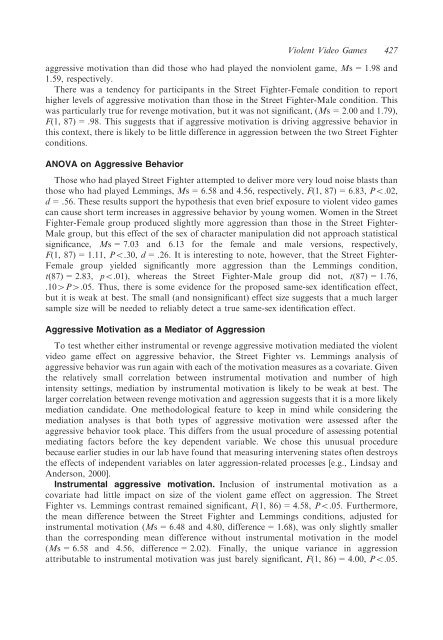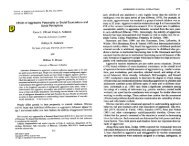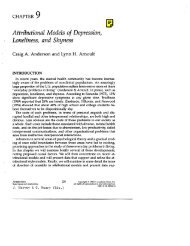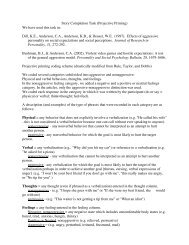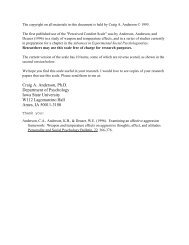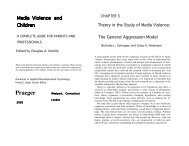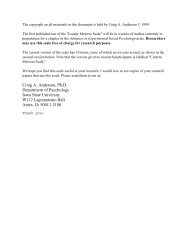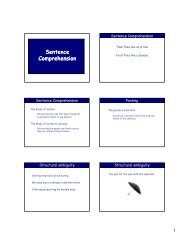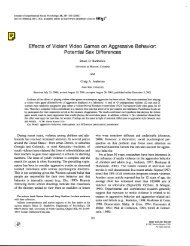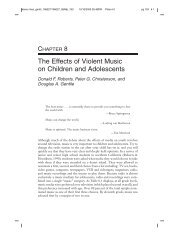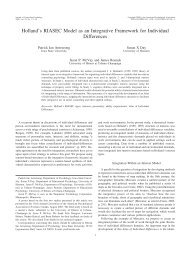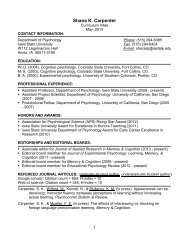Violent Video Games and Aggressive Behavior in Young Women
Violent Video Games and Aggressive Behavior in Young Women
Violent Video Games and Aggressive Behavior in Young Women
Create successful ePaper yourself
Turn your PDF publications into a flip-book with our unique Google optimized e-Paper software.
<strong>Violent</strong> <strong>Video</strong> <strong>Games</strong> 427<br />
aggressive motivation than did those who had played the nonviolent game, Ms = 1.98 <strong>and</strong><br />
1.59, respectively.<br />
There was a tendency for participants <strong>in</strong> the Street Fighter-Female condition to report<br />
higher levels of aggressive motivation than those <strong>in</strong> the Street Fighter-Male condition. This<br />
was particularly true for revenge motivation, but it was not significant, (Ms = 2.00 <strong>and</strong> 1.79),<br />
F(1, 87) = .98. This suggests that if aggressive motivation is driv<strong>in</strong>g aggressive behavior <strong>in</strong><br />
this context, there is likely to be little difference <strong>in</strong> aggression between the two Street Fighter<br />
conditions.<br />
ANOVA on <strong>Aggressive</strong> <strong>Behavior</strong><br />
Those who had played Street Fighter attempted to deliver more very loud noise blasts than<br />
those who had played Lemm<strong>in</strong>gs, Ms = 6.58 <strong>and</strong> 4.56, respectively, F(1, 87) = 6.83, Po.02,<br />
d = .56. These results support the hypothesis that even brief exposure to violent video games<br />
can cause short term <strong>in</strong>creases <strong>in</strong> aggressive behavior by young women. <strong>Women</strong> <strong>in</strong> the Street<br />
Fighter-Female group produced slightly more aggression than those <strong>in</strong> the Street Fighter-<br />
Male group, but this effect of the sex of character manipulation did not approach statistical<br />
significance, Ms = 7.03 <strong>and</strong> 6.13 for the female <strong>and</strong> male versions, respectively,<br />
F(1, 87) = 1.11, Po.30, d = .26. It is <strong>in</strong>terest<strong>in</strong>g to note, however, that the Street Fighter-<br />
Female group yielded significantly more aggression than the Lemm<strong>in</strong>gs condition,<br />
t(87) = 2.83, po.01), whereas the Street Fighter-Male group did not, t(87) = 1.76,<br />
.104P4.05. Thus, there is some evidence for the proposed same-sex identification effect,<br />
but it is weak at best. The small (<strong>and</strong> nonsignificant) effect size suggests that a much larger<br />
sample size will be needed to reliably detect a true same-sex identification effect.<br />
<strong>Aggressive</strong> Motivation as a Mediator of Aggression<br />
To test whether either <strong>in</strong>strumental or revenge aggressive motivation mediated the violent<br />
video game effect on aggressive behavior, the Street Fighter vs. Lemm<strong>in</strong>gs analysis of<br />
aggressive behavior was run aga<strong>in</strong> with each of the motivation measures as a covariate. Given<br />
the relatively small correlation between <strong>in</strong>strumental motivation <strong>and</strong> number of high<br />
<strong>in</strong>tensity sett<strong>in</strong>gs, mediation by <strong>in</strong>strumental motivation is likely to be weak at best. The<br />
larger correlation between revenge motivation <strong>and</strong> aggression suggests that it is a more likely<br />
mediation c<strong>and</strong>idate. One methodological feature to keep <strong>in</strong> m<strong>in</strong>d while consider<strong>in</strong>g the<br />
mediation analyses is that both types of aggressive motivation were assessed after the<br />
aggressive behavior took place. This differs from the usual procedure of assess<strong>in</strong>g potential<br />
mediat<strong>in</strong>g factors before the key dependent variable. We chose this unusual procedure<br />
because earlier studies <strong>in</strong> our lab have found that measur<strong>in</strong>g <strong>in</strong>terven<strong>in</strong>g states often destroys<br />
the effects of <strong>in</strong>dependent variables on later aggression-related processes [e.g., L<strong>in</strong>dsay <strong>and</strong><br />
Anderson, 2000].<br />
Instrumental aggressive motivation. Inclusion of <strong>in</strong>strumental motivation as a<br />
covariate had little impact on size of the violent game effect on aggression. The Street<br />
Fighter vs. Lemm<strong>in</strong>gs contrast rema<strong>in</strong>ed significant, F(1, 86) = 4.58, Po.05. Furthermore,<br />
the mean difference between the Street Fighter <strong>and</strong> Lemm<strong>in</strong>gs conditions, adjusted for<br />
<strong>in</strong>strumental motivation (Ms = 6.48 <strong>and</strong> 4.80, difference = 1.68), was only slightly smaller<br />
than the correspond<strong>in</strong>g mean difference without <strong>in</strong>strumental motivation <strong>in</strong> the model<br />
(Ms = 6.58 <strong>and</strong> 4.56, difference = 2.02). F<strong>in</strong>ally, the unique variance <strong>in</strong> aggression<br />
attributable to <strong>in</strong>strumental motivation was just barely significant, F(1, 86) = 4.00, Po.05.


